What is Project Ara? The Google modular smartphone story so far
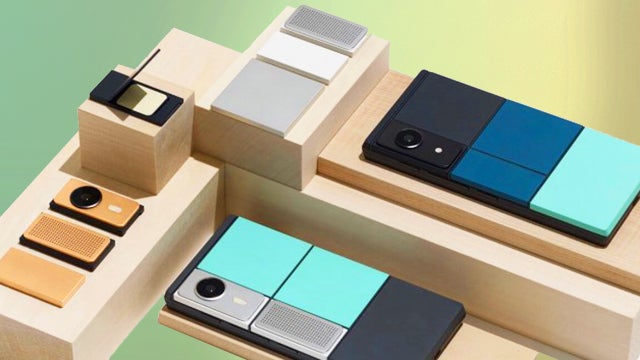
Google has revealed more about its modular smartphone project at Google I/O 2016. Here’s what we know about Project Ara so far.
What’s the best smartphone for you and your particular needs? It’s something many of us agonise over every two years or so.
You might like the Moto X Style‘s customisable design, the iPhone 6S‘s snappy fingerprint sensor, and the Samsung Galaxy S7‘s camera. Sadly, there’s no such thing as a perfect phone that rolls together all of your favourite components into one tidy package.
Project Ara could conceivably become the next best thing, enabling you to effectively build a phone to your own specifications – although the reality won’t go quite as far as the initial concept, as we’ll discuss.
So what exactly is Project Ara, and when will we be able to buy one? Here’s the lowdown on Google’s modular smartphone.
VIDEO: Best smartphone 2016 – What’s the no. 1 phone right now?
What is Project Ara?
Ara, which is named after one of the project’s early instigators, Ara Knaian, is a modular smartphone initiative that was set up by Google in 2013.
It started out being developed within the company’s Advanced Technology and Projects group, which Google held onto when it sold Motorola to Lenovo last year. More recently, it has been given its own department within Google – a sure sign of the importance Google places on it.
The concept behind Project Ara is to be able to build your own Android smartphone from separate interconnecting components. With this higher degree of flexibility, Google hopes to reach more of the billions of people in the world who don’t yet own a smartphone, as well as to breathe innovation into a stagnant smartphone market.
Google thinks of Project Ara as the hardware equivalent of the app ecosystem, where small, single-function pieces of software have led to an explosion in creativity and rapid innovation.
It had all gone dark on Project Ara for more than a year. Our previous update to this feature dates back to February 2015, highlighting how long it’s been since we’ve heard anything new of note from the team.
But as it turns out, Google has been hard at work revising many aspects of the Project Ara venture. The company discussed its progress at Google I/O in May 2016, and it’s remarkably close to completion.
SEE ALSO: Best Android Phones 2016

How does Project Ara work?
The current Project Ara device starts with a base frame onto which you can attach up to six plug-and-play components. There will be larger and smaller frames offered in the future.
Cameras, secondary displays, speakers and more can all be added as modules, and there’s scope for more varied applications. It’s long been envisaged that customers in developing countries could purchase a module that tests a water source for purity, for example, while in more developed regions you might be willing to pay more for a superior camera or a second screen.
In recent times, Google’s design has been simplified somewhat. Project Ara will no longer enable you to swap out core components like the processor, memory, or storage. These will be built into the frame as standard, along with the battery, screen, antennas and sensors. Google says that this will free up more room for truly innovative modules.
The smartphone form factor has arguably been perfected in recent times, with more than enough power and pixels on-tap, even in mid-range phones. Project Ara now gives you the core phone part as standard, and lets you customise from there.
Related: Are modular phones the future?
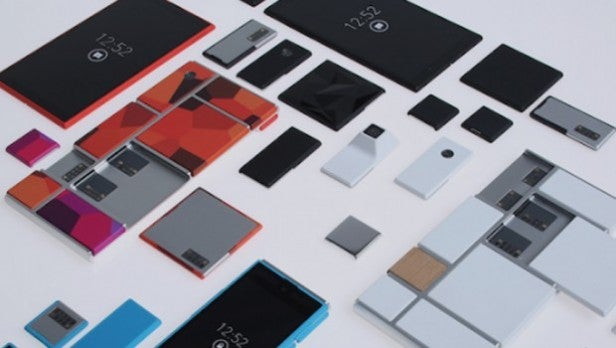
These modules can be added or removed safely even while the phone is powered on (aside from the display for obvious reasons), with a custom app allowing you to ‘eject’ them much like you would a USB drive. There’s a dedicated button that will provide an overview off all of your connected modules and allow you to eject them, but you can also now eject them using vocal commands.
All of these modules are run and swapped seamlessly through a piece of software called Greybus, which according to Google “supports instantaneous connections, power efficiency and data-transfer rates of up to 11.9 Gbps”.
As for the physical construction, Project Ara has progressed from a loose magnetised approach (which reportedly didn’t prove tough enough in early tests) to a system of “durable latches and connectors”. Your carefully assembled Project Ara handset won’t be flying apart at the seams when you drop it, in other words. The modules themselves connect through the open UniPro standard.
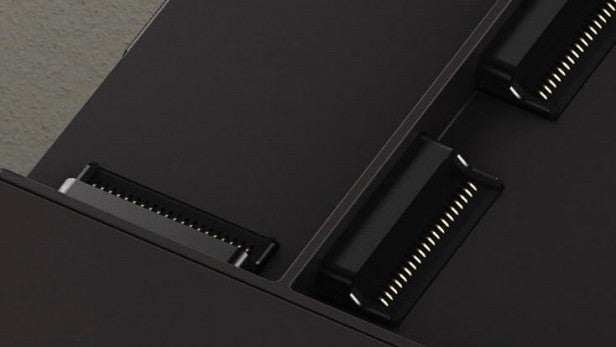
Project Ara modules
A brief video released at Google I/O demonstrates the kind of initial modules you’ll be able to customise your Project Ara base unit with.
Google is teaming up with a number of hardware partners to produce these modules, including Panasonic, TDK, iHealth, E Ink, Toshiba, Sony Pictures Home Entertainment, and Samsung. All will build their disparate modules to Google’s common set standards, which means you’ll be able to upgrade components over successive years.
Here’s Google’s demo video, followed by a breakdown of some of the notable modules contained within it:
Camera
One of the modules with the most potential for personalisation is the camera, and Google’s video appears to show off several different versions. Interestingly, we also spotted a handset without a camera – something that hasn’t been omitted from a major phone in years (not that we can recall, at least). If you’re an avid photographer who always keeps a dedicated camera to hand, you needn’t waste space or money on a camera module.
Related: What is Project Tango?
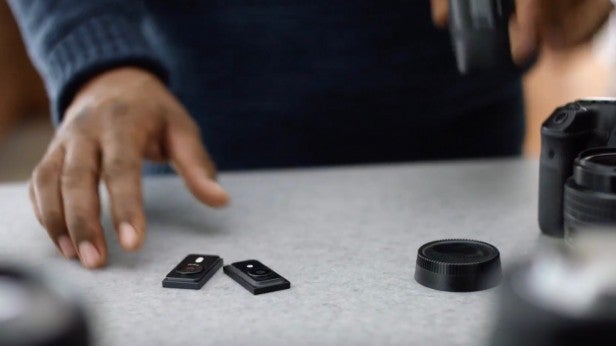
Secondary screen
The video highlights a small square screen that can be slotted onto the back of the Project Ara device – possibly utilising low-energy, high-visibility E-ink display technology. Here it’s used to display weather information, hinting at the kind of glanceable info it’ll be useful for.
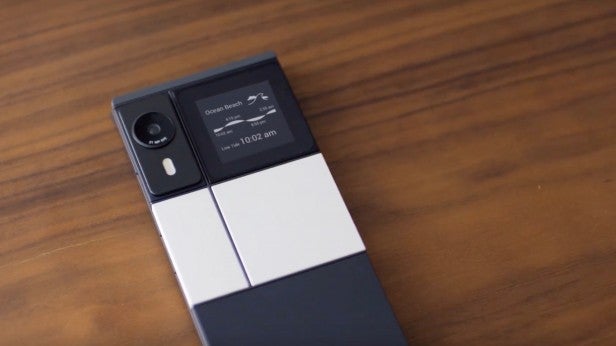
Kickstand
From the high-tech to the decidedly low-tech, the video shows off a kickstand module that will be handy for those who like to prop their phones up for media or group selfie purposes.
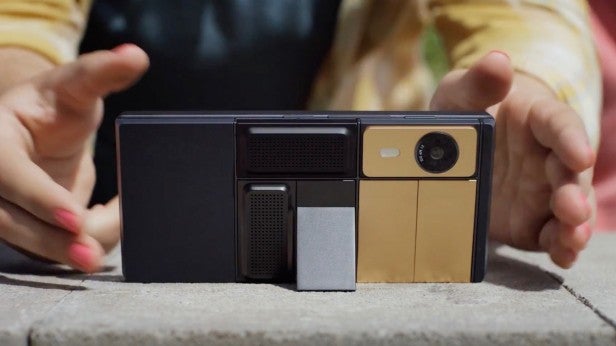
Speaker
One of the most visually (and audibly) striking modules on display here is the small loudspeaker unit, which occupies one of the rectangular slots on the frame. The video even shows off a guitar-strumming lady who’s gone with three speaker modules, one of which looks to be of a different variety to the others.
Meanwhile the final image is of an Ara device, face-down on the floor, with what appear to be a couple of larger speaker modules attached alongside one of those smaller ones. Presumably the idea is that the phone can act as some sort of portable public media player.
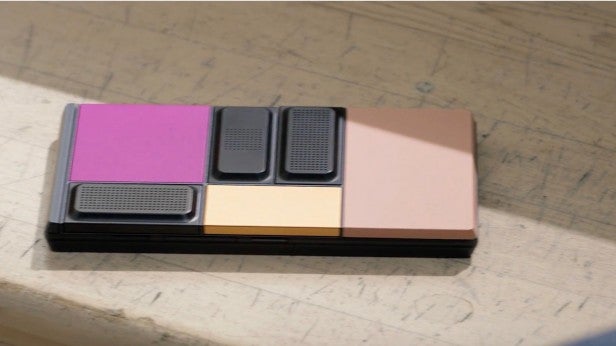
GPS
We don’t see the actual module, as such, but Google’s video uses a runner reaching a fork in a mountain trail to show that there’ll be a plug-in GPS option, or perhaps some kind of advanced sensor array for fitness fanatics.

When will Project Ara launch?
At Google I/O 2016, the company announced that it would be releasing a new developer version (complete with a 5.3-inch screen) of Project Ara in autumn 2016.
It was also confirmed that a consumer version would hit shops in 2017. Google’s final design will reportedly by a fair bit thinner and more elegant than the prototypes pictured in this article.
READ: LG G5 modular phone review
How much will Project Ara cost?
Back at the beginning of 2015, Google was aiming for the cost of materials of a basic entry-level model to be in the $50–100 range – which would have worked out to roughly £35-£70. Modules, meanwhile, were in line to cost anything between $50 and $500, according to early statements made by hardware partner Toshiba.
As we’ve already discussed, though, Google has revised its Project Ara design fairly extensively since then, so we don’t have much of an indication as to how much the final setup will cost.
Are you excited about Project Ara? Do you think modular smartphones are the future? Let us know in the comments section below


